Workforce Planning: Analysis & Strategies in Business Law
VerifiedAdded on 2023/04/22
|19
|4559
|315
Project
AI Summary
This project provides a detailed analysis of workforce planning, covering aspects such as forecasting and assessment, succession planning, and recruitment strategies. It discusses the importance of understanding labor demand and supply, industrial relations, and the factors affecting workforce planning, including external and internal influences. The project also explores strategies for attracting and retaining skilled labor, the significance of contingency plans, and their impact on industrial relations. The analysis incorporates various workforce planning models and highlights the role of gap analysis in identifying and addressing workforce needs. Desklib offers this document as a resource for students studying workforce management and business law, providing insights and solved assignments for enhanced learning.
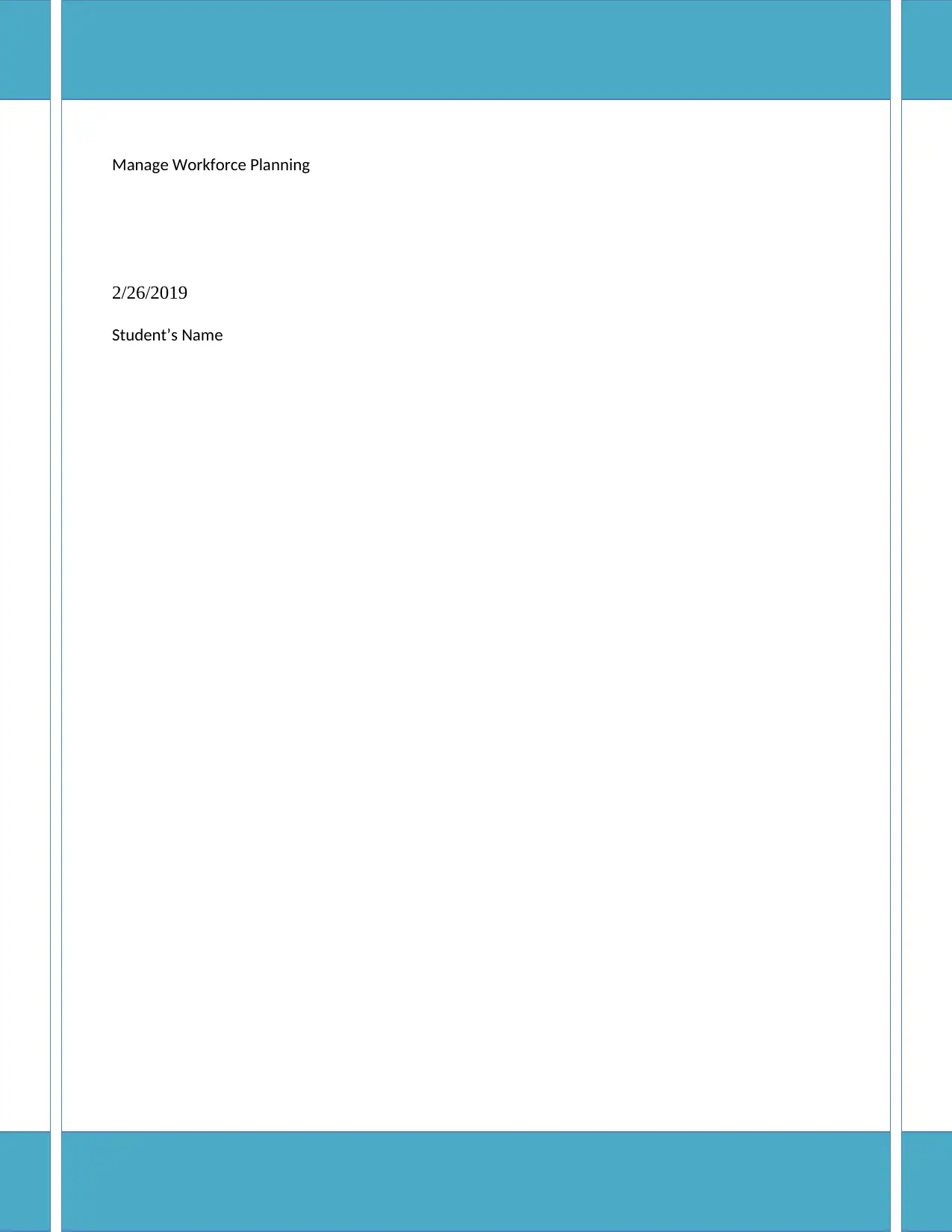
Running Head: BUSINESS AND CORPORATION LAW 0
Manage Workforce Planning
2/26/2019
Student’s Name
Manage Workforce Planning
2/26/2019
Student’s Name
Paraphrase This Document
Need a fresh take? Get an instant paraphrase of this document with our AI Paraphraser
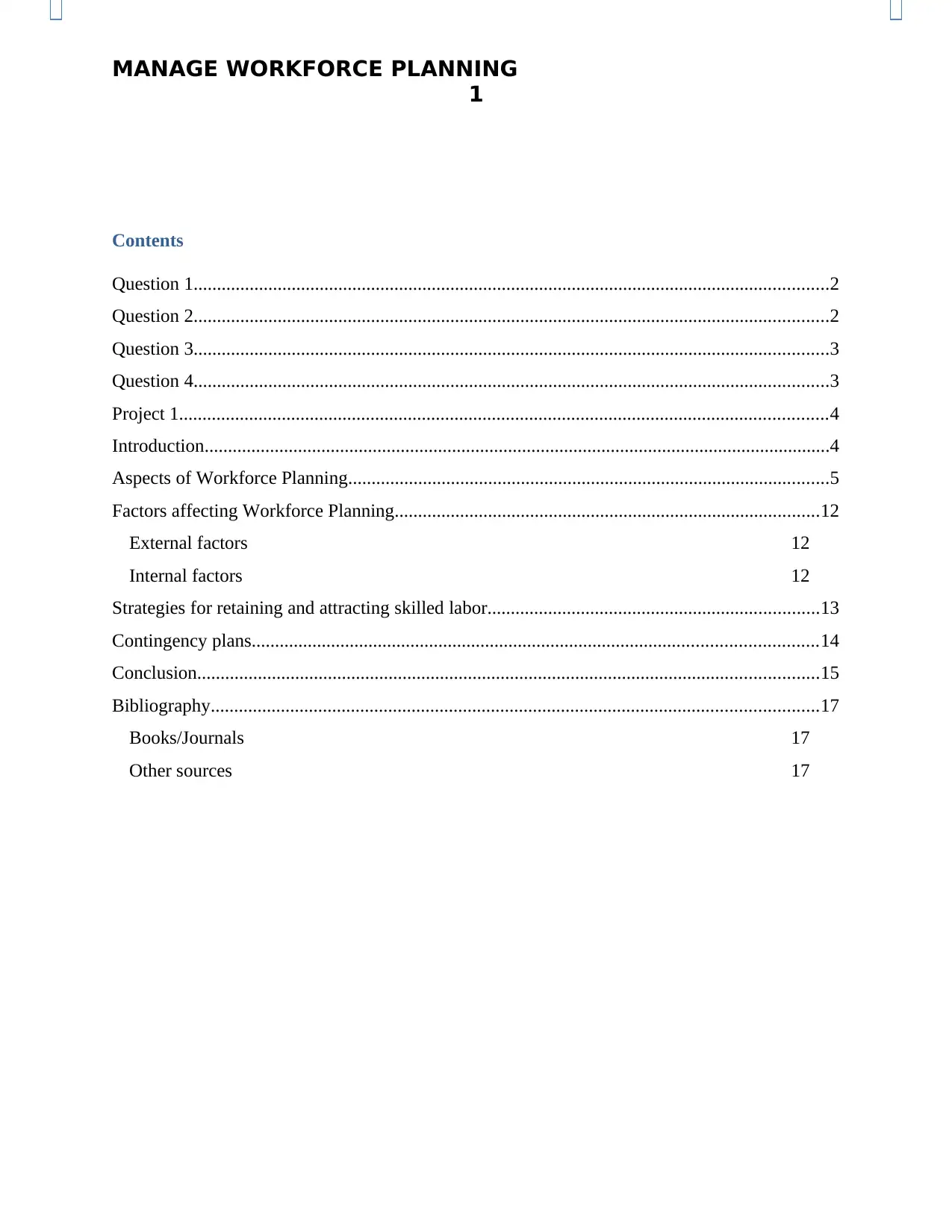
MANAGE WORKFORCE PLANNING
1
Contents
Question 1........................................................................................................................................2
Question 2........................................................................................................................................2
Question 3........................................................................................................................................3
Question 4........................................................................................................................................3
Project 1...........................................................................................................................................4
Introduction......................................................................................................................................4
Aspects of Workforce Planning.......................................................................................................5
Factors affecting Workforce Planning...........................................................................................12
External factors 12
Internal factors 12
Strategies for retaining and attracting skilled labor.......................................................................13
Contingency plans.........................................................................................................................14
Conclusion.....................................................................................................................................15
Bibliography..................................................................................................................................17
Books/Journals 17
Other sources 17
1
Contents
Question 1........................................................................................................................................2
Question 2........................................................................................................................................2
Question 3........................................................................................................................................3
Question 4........................................................................................................................................3
Project 1...........................................................................................................................................4
Introduction......................................................................................................................................4
Aspects of Workforce Planning.......................................................................................................5
Factors affecting Workforce Planning...........................................................................................12
External factors 12
Internal factors 12
Strategies for retaining and attracting skilled labor.......................................................................13
Contingency plans.........................................................................................................................14
Conclusion.....................................................................................................................................15
Bibliography..................................................................................................................................17
Books/Journals 17
Other sources 17
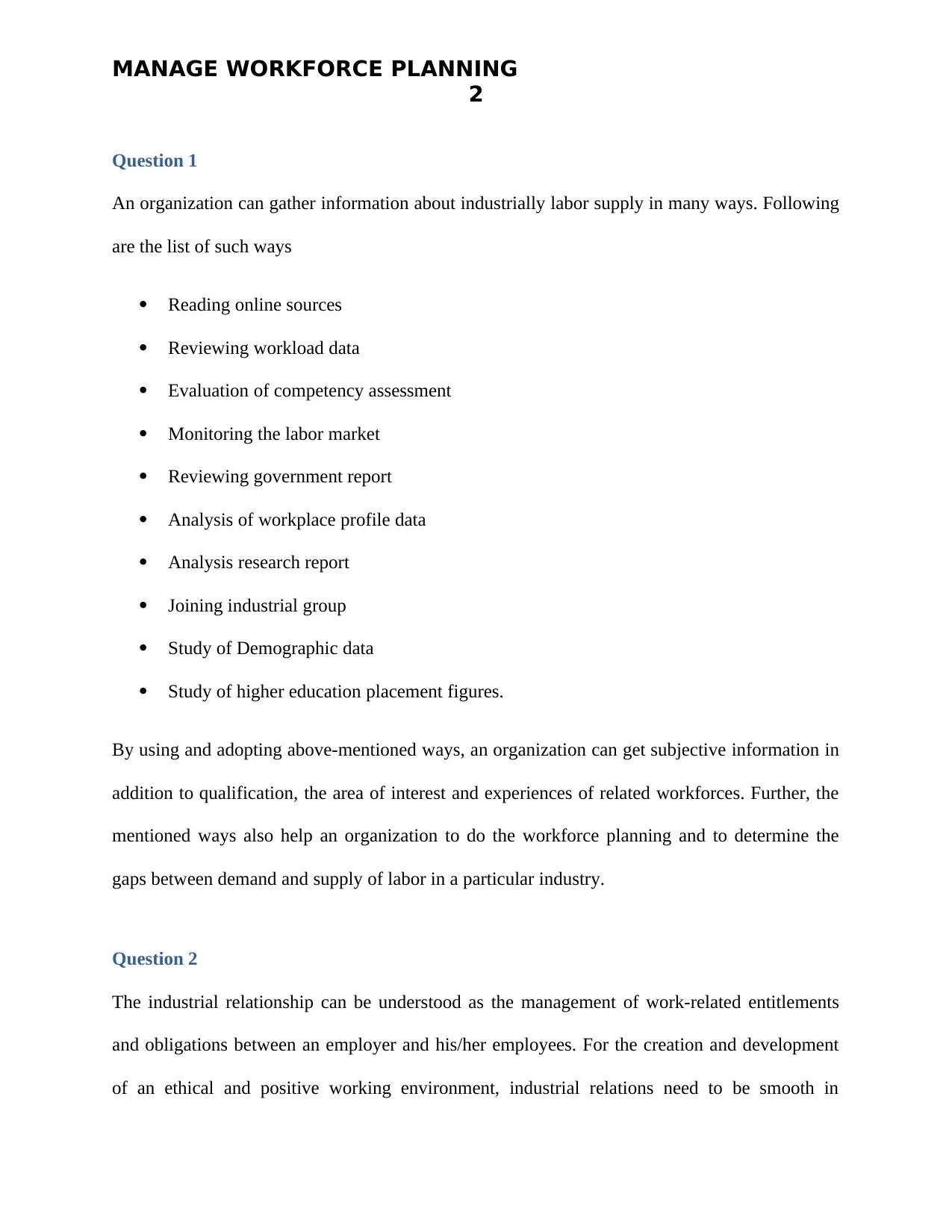
MANAGE WORKFORCE PLANNING
2
Question 1
An organization can gather information about industrially labor supply in many ways. Following
are the list of such ways
Reading online sources
Reviewing workload data
Evaluation of competency assessment
Monitoring the labor market
Reviewing government report
Analysis of workplace profile data
Analysis research report
Joining industrial group
Study of Demographic data
Study of higher education placement figures.
By using and adopting above-mentioned ways, an organization can get subjective information in
addition to qualification, the area of interest and experiences of related workforces. Further, the
mentioned ways also help an organization to do the workforce planning and to determine the
gaps between demand and supply of labor in a particular industry.
Question 2
The industrial relationship can be understood as the management of work-related entitlements
and obligations between an employer and his/her employees. For the creation and development
of an ethical and positive working environment, industrial relations need to be smooth in
2
Question 1
An organization can gather information about industrially labor supply in many ways. Following
are the list of such ways
Reading online sources
Reviewing workload data
Evaluation of competency assessment
Monitoring the labor market
Reviewing government report
Analysis of workplace profile data
Analysis research report
Joining industrial group
Study of Demographic data
Study of higher education placement figures.
By using and adopting above-mentioned ways, an organization can get subjective information in
addition to qualification, the area of interest and experiences of related workforces. Further, the
mentioned ways also help an organization to do the workforce planning and to determine the
gaps between demand and supply of labor in a particular industry.
Question 2
The industrial relationship can be understood as the management of work-related entitlements
and obligations between an employer and his/her employees. For the creation and development
of an ethical and positive working environment, industrial relations need to be smooth in
⊘ This is a preview!⊘
Do you want full access?
Subscribe today to unlock all pages.

Trusted by 1+ million students worldwide
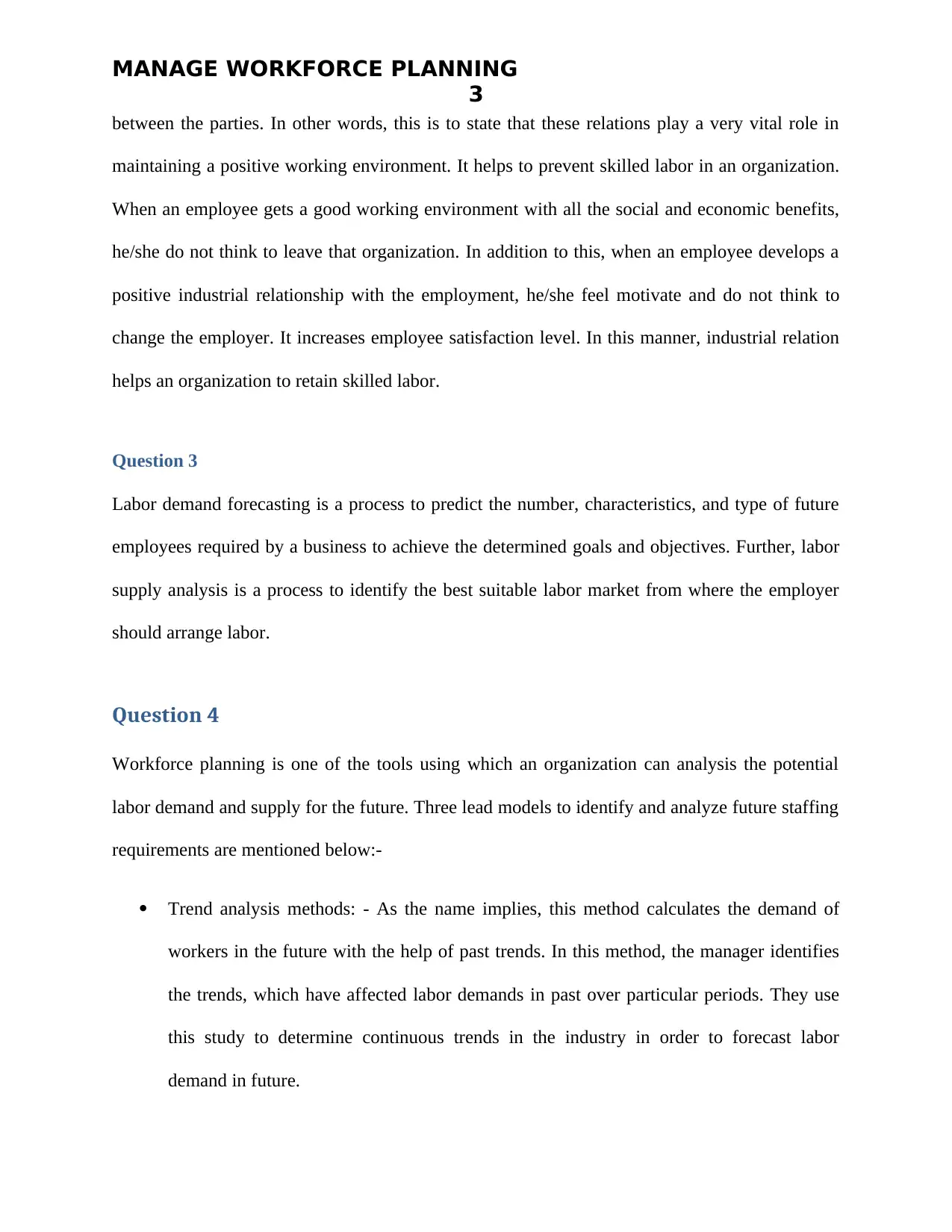
MANAGE WORKFORCE PLANNING
3
between the parties. In other words, this is to state that these relations play a very vital role in
maintaining a positive working environment. It helps to prevent skilled labor in an organization.
When an employee gets a good working environment with all the social and economic benefits,
he/she do not think to leave that organization. In addition to this, when an employee develops a
positive industrial relationship with the employment, he/she feel motivate and do not think to
change the employer. It increases employee satisfaction level. In this manner, industrial relation
helps an organization to retain skilled labor.
Question 3
Labor demand forecasting is a process to predict the number, characteristics, and type of future
employees required by a business to achieve the determined goals and objectives. Further, labor
supply analysis is a process to identify the best suitable labor market from where the employer
should arrange labor.
Question 4
Workforce planning is one of the tools using which an organization can analysis the potential
labor demand and supply for the future. Three lead models to identify and analyze future staffing
requirements are mentioned below:-
Trend analysis methods: - As the name implies, this method calculates the demand of
workers in the future with the help of past trends. In this method, the manager identifies
the trends, which have affected labor demands in past over particular periods. They use
this study to determine continuous trends in the industry in order to forecast labor
demand in future.
3
between the parties. In other words, this is to state that these relations play a very vital role in
maintaining a positive working environment. It helps to prevent skilled labor in an organization.
When an employee gets a good working environment with all the social and economic benefits,
he/she do not think to leave that organization. In addition to this, when an employee develops a
positive industrial relationship with the employment, he/she feel motivate and do not think to
change the employer. It increases employee satisfaction level. In this manner, industrial relation
helps an organization to retain skilled labor.
Question 3
Labor demand forecasting is a process to predict the number, characteristics, and type of future
employees required by a business to achieve the determined goals and objectives. Further, labor
supply analysis is a process to identify the best suitable labor market from where the employer
should arrange labor.
Question 4
Workforce planning is one of the tools using which an organization can analysis the potential
labor demand and supply for the future. Three lead models to identify and analyze future staffing
requirements are mentioned below:-
Trend analysis methods: - As the name implies, this method calculates the demand of
workers in the future with the help of past trends. In this method, the manager identifies
the trends, which have affected labor demands in past over particular periods. They use
this study to determine continuous trends in the industry in order to forecast labor
demand in future.
Paraphrase This Document
Need a fresh take? Get an instant paraphrase of this document with our AI Paraphraser
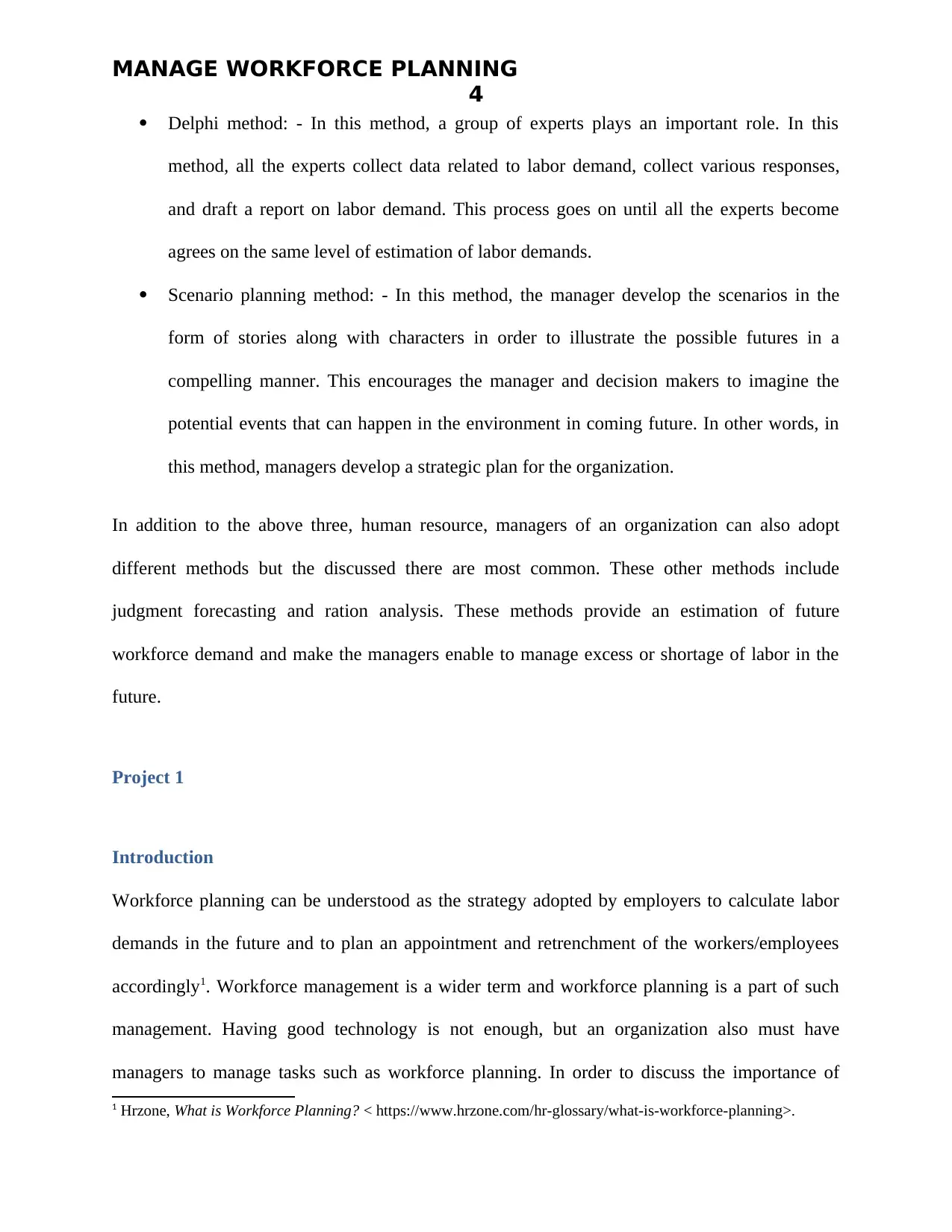
MANAGE WORKFORCE PLANNING
4
Delphi method: - In this method, a group of experts plays an important role. In this
method, all the experts collect data related to labor demand, collect various responses,
and draft a report on labor demand. This process goes on until all the experts become
agrees on the same level of estimation of labor demands.
Scenario planning method: - In this method, the manager develop the scenarios in the
form of stories along with characters in order to illustrate the possible futures in a
compelling manner. This encourages the manager and decision makers to imagine the
potential events that can happen in the environment in coming future. In other words, in
this method, managers develop a strategic plan for the organization.
In addition to the above three, human resource, managers of an organization can also adopt
different methods but the discussed there are most common. These other methods include
judgment forecasting and ration analysis. These methods provide an estimation of future
workforce demand and make the managers enable to manage excess or shortage of labor in the
future.
Project 1
Introduction
Workforce planning can be understood as the strategy adopted by employers to calculate labor
demands in the future and to plan an appointment and retrenchment of the workers/employees
accordingly1. Workforce management is a wider term and workforce planning is a part of such
management. Having good technology is not enough, but an organization also must have
managers to manage tasks such as workforce planning. In order to discuss the importance of
1 Hrzone, What is Workforce Planning? < https://www.hrzone.com/hr-glossary/what-is-workforce-planning>.
4
Delphi method: - In this method, a group of experts plays an important role. In this
method, all the experts collect data related to labor demand, collect various responses,
and draft a report on labor demand. This process goes on until all the experts become
agrees on the same level of estimation of labor demands.
Scenario planning method: - In this method, the manager develop the scenarios in the
form of stories along with characters in order to illustrate the possible futures in a
compelling manner. This encourages the manager and decision makers to imagine the
potential events that can happen in the environment in coming future. In other words, in
this method, managers develop a strategic plan for the organization.
In addition to the above three, human resource, managers of an organization can also adopt
different methods but the discussed there are most common. These other methods include
judgment forecasting and ration analysis. These methods provide an estimation of future
workforce demand and make the managers enable to manage excess or shortage of labor in the
future.
Project 1
Introduction
Workforce planning can be understood as the strategy adopted by employers to calculate labor
demands in the future and to plan an appointment and retrenchment of the workers/employees
accordingly1. Workforce management is a wider term and workforce planning is a part of such
management. Having good technology is not enough, but an organization also must have
managers to manage tasks such as workforce planning. In order to discuss the importance of
1 Hrzone, What is Workforce Planning? < https://www.hrzone.com/hr-glossary/what-is-workforce-planning>.
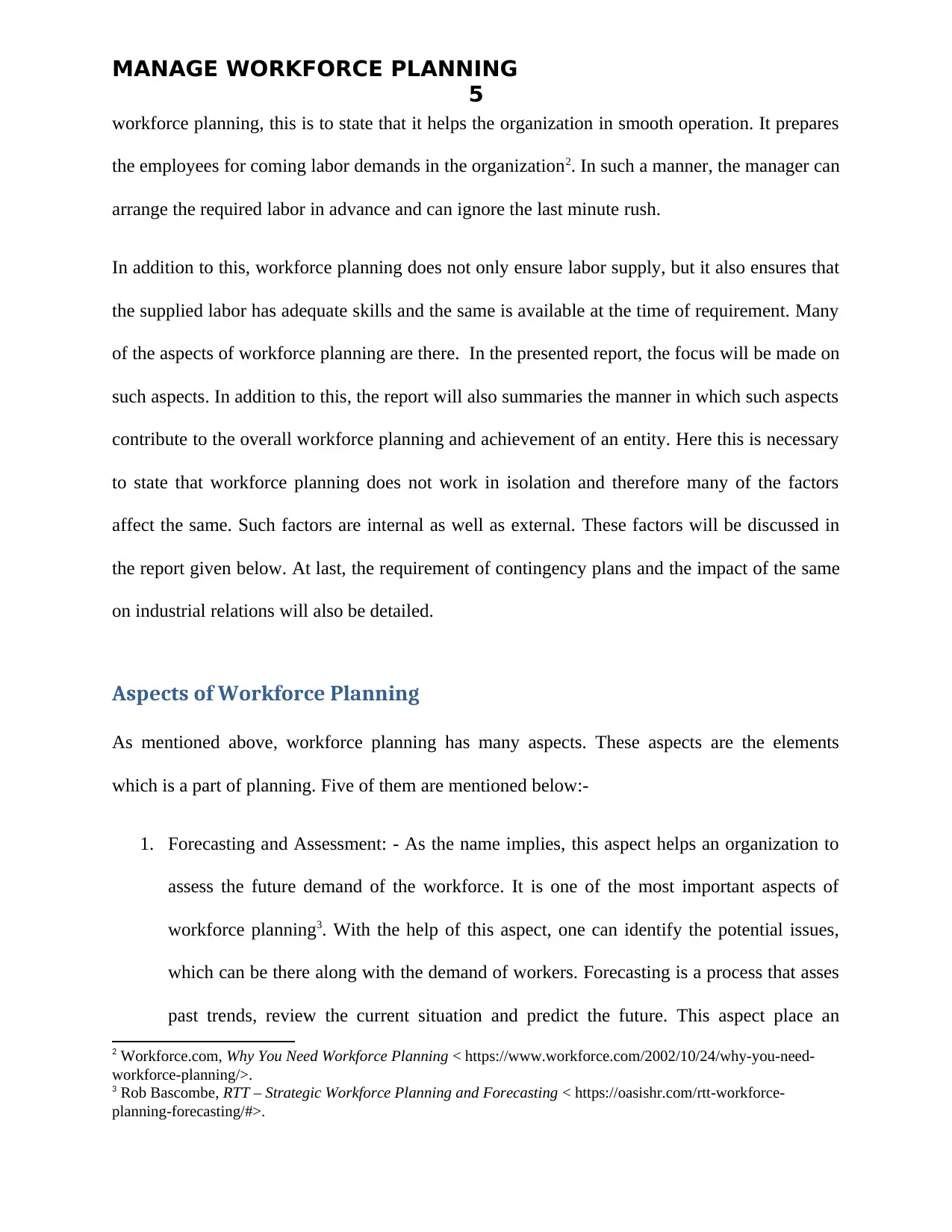
MANAGE WORKFORCE PLANNING
5
workforce planning, this is to state that it helps the organization in smooth operation. It prepares
the employees for coming labor demands in the organization2. In such a manner, the manager can
arrange the required labor in advance and can ignore the last minute rush.
In addition to this, workforce planning does not only ensure labor supply, but it also ensures that
the supplied labor has adequate skills and the same is available at the time of requirement. Many
of the aspects of workforce planning are there. In the presented report, the focus will be made on
such aspects. In addition to this, the report will also summaries the manner in which such aspects
contribute to the overall workforce planning and achievement of an entity. Here this is necessary
to state that workforce planning does not work in isolation and therefore many of the factors
affect the same. Such factors are internal as well as external. These factors will be discussed in
the report given below. At last, the requirement of contingency plans and the impact of the same
on industrial relations will also be detailed.
Aspects of Workforce Planning
As mentioned above, workforce planning has many aspects. These aspects are the elements
which is a part of planning. Five of them are mentioned below:-
1. Forecasting and Assessment: - As the name implies, this aspect helps an organization to
assess the future demand of the workforce. It is one of the most important aspects of
workforce planning3. With the help of this aspect, one can identify the potential issues,
which can be there along with the demand of workers. Forecasting is a process that asses
past trends, review the current situation and predict the future. This aspect place an
2 Workforce.com, Why You Need Workforce Planning < https://www.workforce.com/2002/10/24/why-you-need-
workforce-planning/>.
3 Rob Bascombe, RTT – Strategic Workforce Planning and Forecasting < https://oasishr.com/rtt-workforce-
planning-forecasting/#>.
5
workforce planning, this is to state that it helps the organization in smooth operation. It prepares
the employees for coming labor demands in the organization2. In such a manner, the manager can
arrange the required labor in advance and can ignore the last minute rush.
In addition to this, workforce planning does not only ensure labor supply, but it also ensures that
the supplied labor has adequate skills and the same is available at the time of requirement. Many
of the aspects of workforce planning are there. In the presented report, the focus will be made on
such aspects. In addition to this, the report will also summaries the manner in which such aspects
contribute to the overall workforce planning and achievement of an entity. Here this is necessary
to state that workforce planning does not work in isolation and therefore many of the factors
affect the same. Such factors are internal as well as external. These factors will be discussed in
the report given below. At last, the requirement of contingency plans and the impact of the same
on industrial relations will also be detailed.
Aspects of Workforce Planning
As mentioned above, workforce planning has many aspects. These aspects are the elements
which is a part of planning. Five of them are mentioned below:-
1. Forecasting and Assessment: - As the name implies, this aspect helps an organization to
assess the future demand of the workforce. It is one of the most important aspects of
workforce planning3. With the help of this aspect, one can identify the potential issues,
which can be there along with the demand of workers. Forecasting is a process that asses
past trends, review the current situation and predict the future. This aspect place an
2 Workforce.com, Why You Need Workforce Planning < https://www.workforce.com/2002/10/24/why-you-need-
workforce-planning/>.
3 Rob Bascombe, RTT – Strategic Workforce Planning and Forecasting < https://oasishr.com/rtt-workforce-
planning-forecasting/#>.
⊘ This is a preview!⊘
Do you want full access?
Subscribe today to unlock all pages.

Trusted by 1+ million students worldwide
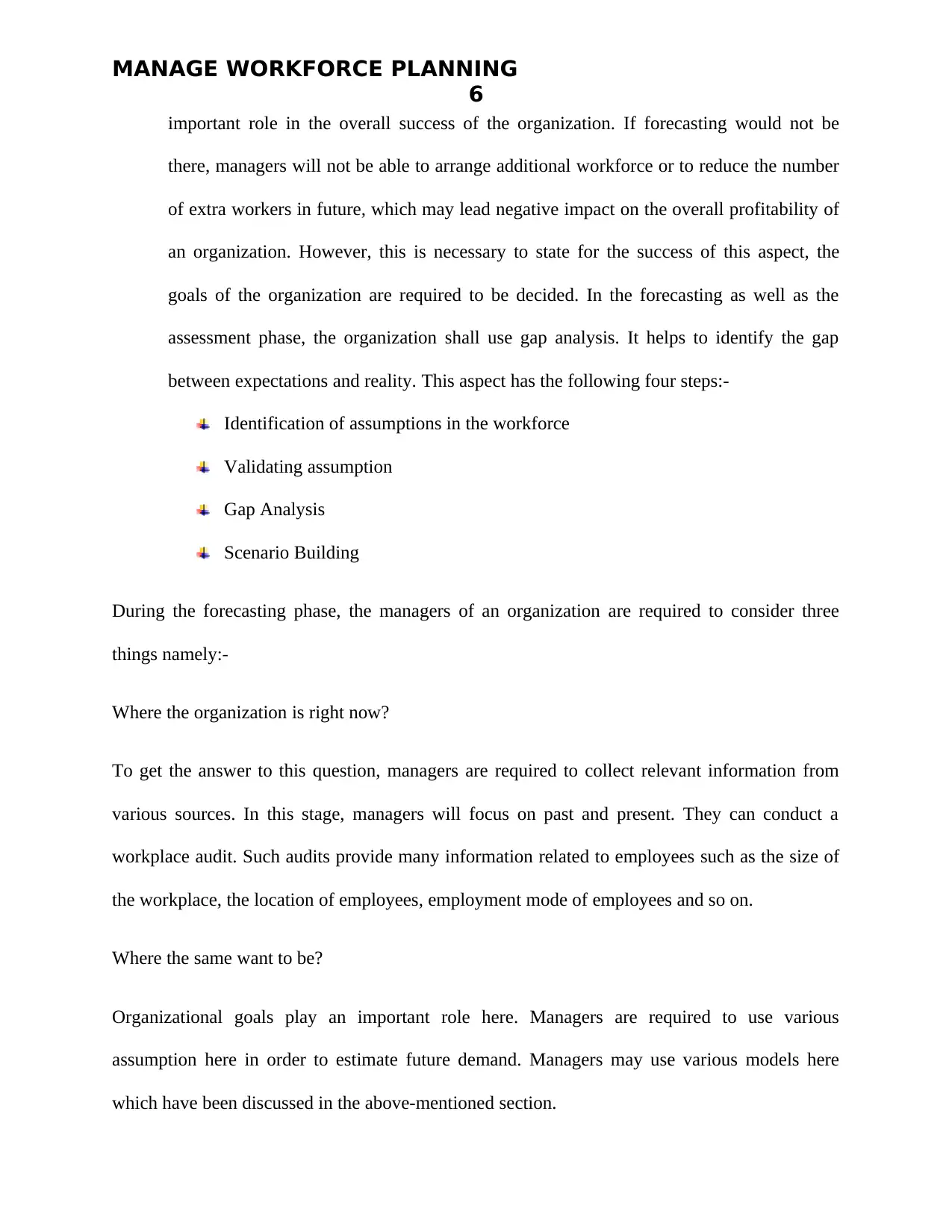
MANAGE WORKFORCE PLANNING
6
important role in the overall success of the organization. If forecasting would not be
there, managers will not be able to arrange additional workforce or to reduce the number
of extra workers in future, which may lead negative impact on the overall profitability of
an organization. However, this is necessary to state for the success of this aspect, the
goals of the organization are required to be decided. In the forecasting as well as the
assessment phase, the organization shall use gap analysis. It helps to identify the gap
between expectations and reality. This aspect has the following four steps:-
Identification of assumptions in the workforce
Validating assumption
Gap Analysis
Scenario Building
During the forecasting phase, the managers of an organization are required to consider three
things namely:-
Where the organization is right now?
To get the answer to this question, managers are required to collect relevant information from
various sources. In this stage, managers will focus on past and present. They can conduct a
workplace audit. Such audits provide many information related to employees such as the size of
the workplace, the location of employees, employment mode of employees and so on.
Where the same want to be?
Organizational goals play an important role here. Managers are required to use various
assumption here in order to estimate future demand. Managers may use various models here
which have been discussed in the above-mentioned section.
6
important role in the overall success of the organization. If forecasting would not be
there, managers will not be able to arrange additional workforce or to reduce the number
of extra workers in future, which may lead negative impact on the overall profitability of
an organization. However, this is necessary to state for the success of this aspect, the
goals of the organization are required to be decided. In the forecasting as well as the
assessment phase, the organization shall use gap analysis. It helps to identify the gap
between expectations and reality. This aspect has the following four steps:-
Identification of assumptions in the workforce
Validating assumption
Gap Analysis
Scenario Building
During the forecasting phase, the managers of an organization are required to consider three
things namely:-
Where the organization is right now?
To get the answer to this question, managers are required to collect relevant information from
various sources. In this stage, managers will focus on past and present. They can conduct a
workplace audit. Such audits provide many information related to employees such as the size of
the workplace, the location of employees, employment mode of employees and so on.
Where the same want to be?
Organizational goals play an important role here. Managers are required to use various
assumption here in order to estimate future demand. Managers may use various models here
which have been discussed in the above-mentioned section.
Paraphrase This Document
Need a fresh take? Get an instant paraphrase of this document with our AI Paraphraser
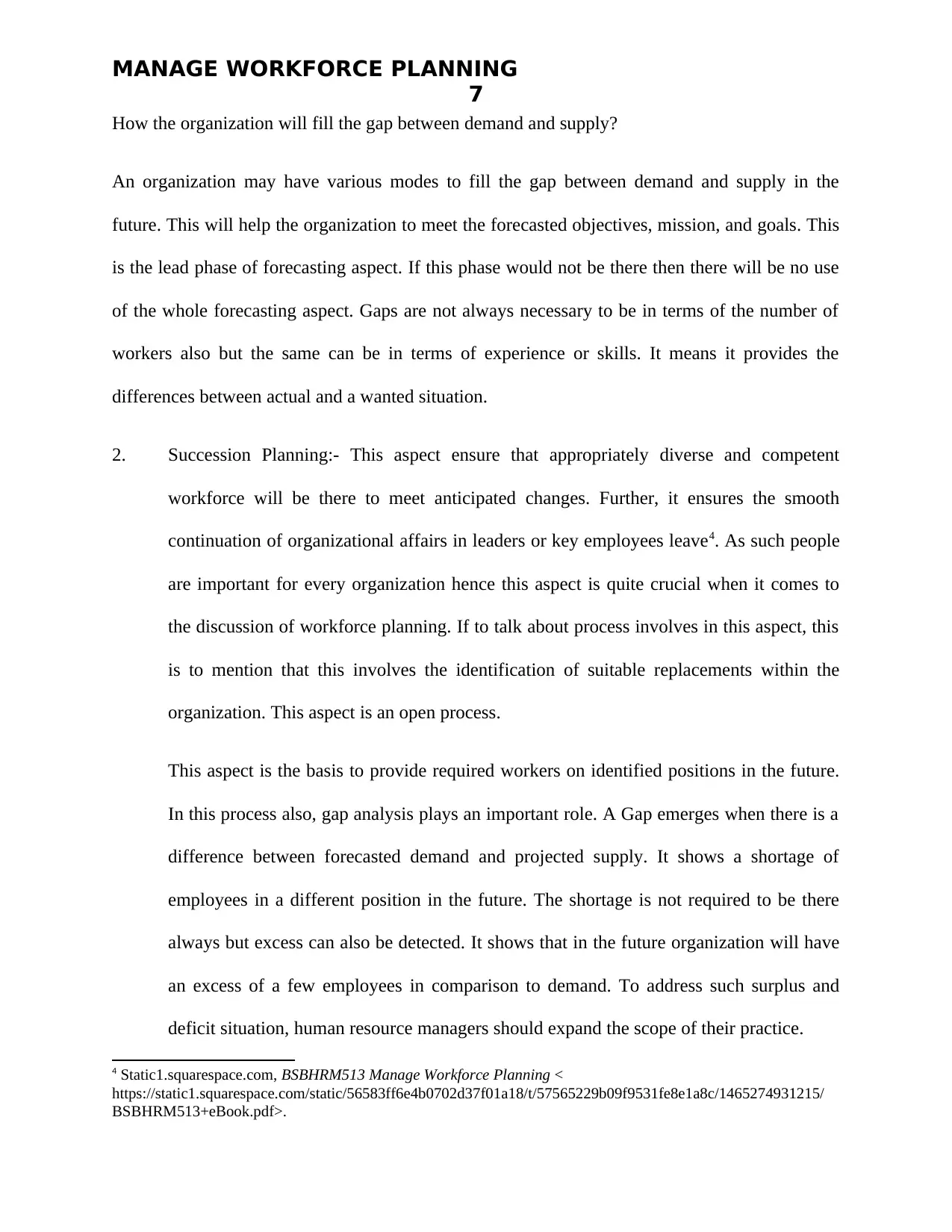
MANAGE WORKFORCE PLANNING
7
How the organization will fill the gap between demand and supply?
An organization may have various modes to fill the gap between demand and supply in the
future. This will help the organization to meet the forecasted objectives, mission, and goals. This
is the lead phase of forecasting aspect. If this phase would not be there then there will be no use
of the whole forecasting aspect. Gaps are not always necessary to be in terms of the number of
workers also but the same can be in terms of experience or skills. It means it provides the
differences between actual and a wanted situation.
2. Succession Planning:- This aspect ensure that appropriately diverse and competent
workforce will be there to meet anticipated changes. Further, it ensures the smooth
continuation of organizational affairs in leaders or key employees leave4. As such people
are important for every organization hence this aspect is quite crucial when it comes to
the discussion of workforce planning. If to talk about process involves in this aspect, this
is to mention that this involves the identification of suitable replacements within the
organization. This aspect is an open process.
This aspect is the basis to provide required workers on identified positions in the future.
In this process also, gap analysis plays an important role. A Gap emerges when there is a
difference between forecasted demand and projected supply. It shows a shortage of
employees in a different position in the future. The shortage is not required to be there
always but excess can also be detected. It shows that in the future organization will have
an excess of a few employees in comparison to demand. To address such surplus and
deficit situation, human resource managers should expand the scope of their practice.
4 Static1.squarespace.com, BSBHRM513 Manage Workforce Planning <
https://static1.squarespace.com/static/56583ff6e4b0702d37f01a18/t/57565229b09f9531fe8e1a8c/1465274931215/
BSBHRM513+eBook.pdf>.
7
How the organization will fill the gap between demand and supply?
An organization may have various modes to fill the gap between demand and supply in the
future. This will help the organization to meet the forecasted objectives, mission, and goals. This
is the lead phase of forecasting aspect. If this phase would not be there then there will be no use
of the whole forecasting aspect. Gaps are not always necessary to be in terms of the number of
workers also but the same can be in terms of experience or skills. It means it provides the
differences between actual and a wanted situation.
2. Succession Planning:- This aspect ensure that appropriately diverse and competent
workforce will be there to meet anticipated changes. Further, it ensures the smooth
continuation of organizational affairs in leaders or key employees leave4. As such people
are important for every organization hence this aspect is quite crucial when it comes to
the discussion of workforce planning. If to talk about process involves in this aspect, this
is to mention that this involves the identification of suitable replacements within the
organization. This aspect is an open process.
This aspect is the basis to provide required workers on identified positions in the future.
In this process also, gap analysis plays an important role. A Gap emerges when there is a
difference between forecasted demand and projected supply. It shows a shortage of
employees in a different position in the future. The shortage is not required to be there
always but excess can also be detected. It shows that in the future organization will have
an excess of a few employees in comparison to demand. To address such surplus and
deficit situation, human resource managers should expand the scope of their practice.
4 Static1.squarespace.com, BSBHRM513 Manage Workforce Planning <
https://static1.squarespace.com/static/56583ff6e4b0702d37f01a18/t/57565229b09f9531fe8e1a8c/1465274931215/
BSBHRM513+eBook.pdf>.
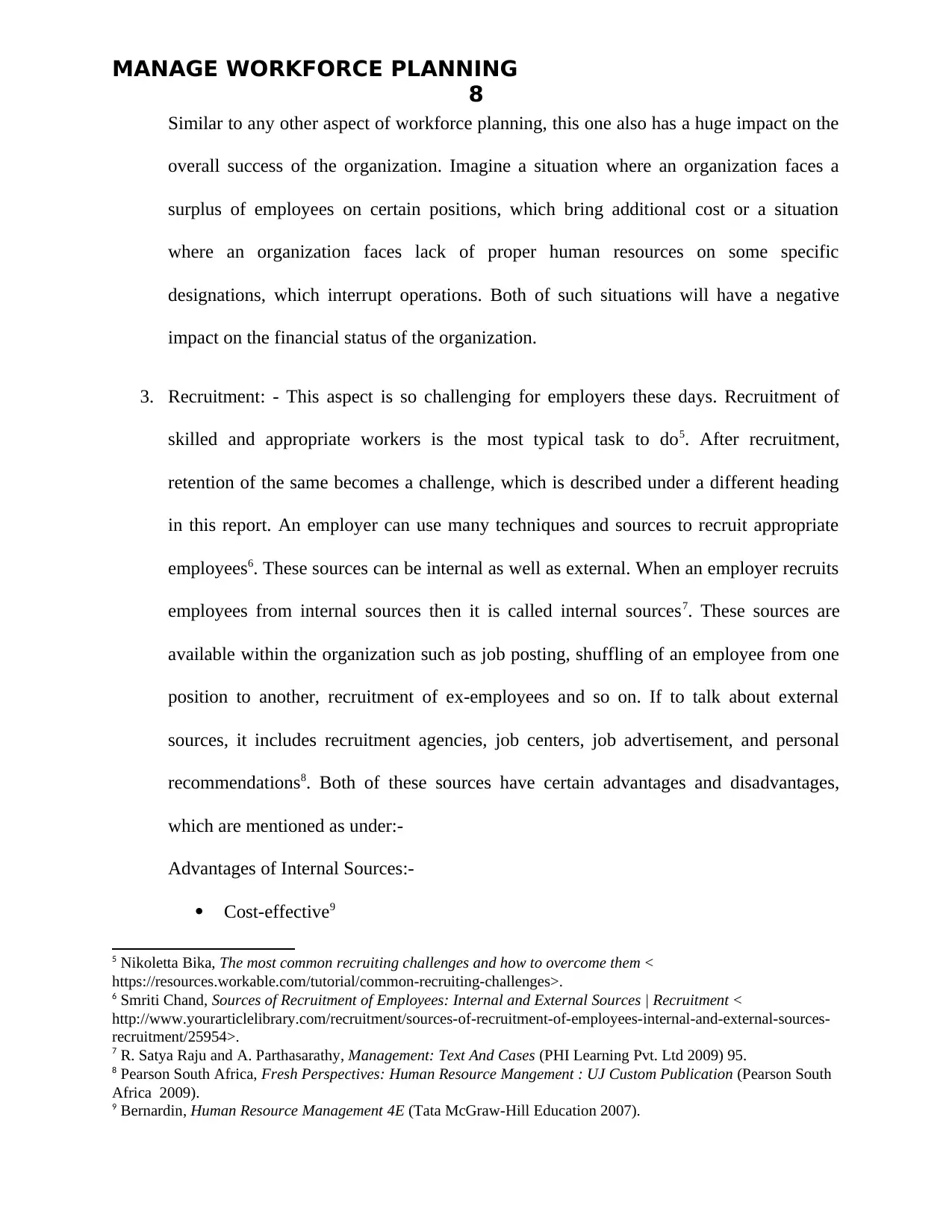
MANAGE WORKFORCE PLANNING
8
Similar to any other aspect of workforce planning, this one also has a huge impact on the
overall success of the organization. Imagine a situation where an organization faces a
surplus of employees on certain positions, which bring additional cost or a situation
where an organization faces lack of proper human resources on some specific
designations, which interrupt operations. Both of such situations will have a negative
impact on the financial status of the organization.
3. Recruitment: - This aspect is so challenging for employers these days. Recruitment of
skilled and appropriate workers is the most typical task to do5. After recruitment,
retention of the same becomes a challenge, which is described under a different heading
in this report. An employer can use many techniques and sources to recruit appropriate
employees6. These sources can be internal as well as external. When an employer recruits
employees from internal sources then it is called internal sources7. These sources are
available within the organization such as job posting, shuffling of an employee from one
position to another, recruitment of ex-employees and so on. If to talk about external
sources, it includes recruitment agencies, job centers, job advertisement, and personal
recommendations8. Both of these sources have certain advantages and disadvantages,
which are mentioned as under:-
Advantages of Internal Sources:-
Cost-effective9
5 Nikoletta Bika, The most common recruiting challenges and how to overcome them <
https://resources.workable.com/tutorial/common-recruiting-challenges>.
6 Smriti Chand, Sources of Recruitment of Employees: Internal and External Sources | Recruitment <
http://www.yourarticlelibrary.com/recruitment/sources-of-recruitment-of-employees-internal-and-external-sources-
recruitment/25954>.
7 R. Satya Raju and A. Parthasarathy, Management: Text And Cases (PHI Learning Pvt. Ltd 2009) 95.
8 Pearson South Africa, Fresh Perspectives: Human Resource Mangement : UJ Custom Publication (Pearson South
Africa 2009).
9 Bernardin, Human Resource Management 4E (Tata McGraw-Hill Education 2007).
8
Similar to any other aspect of workforce planning, this one also has a huge impact on the
overall success of the organization. Imagine a situation where an organization faces a
surplus of employees on certain positions, which bring additional cost or a situation
where an organization faces lack of proper human resources on some specific
designations, which interrupt operations. Both of such situations will have a negative
impact on the financial status of the organization.
3. Recruitment: - This aspect is so challenging for employers these days. Recruitment of
skilled and appropriate workers is the most typical task to do5. After recruitment,
retention of the same becomes a challenge, which is described under a different heading
in this report. An employer can use many techniques and sources to recruit appropriate
employees6. These sources can be internal as well as external. When an employer recruits
employees from internal sources then it is called internal sources7. These sources are
available within the organization such as job posting, shuffling of an employee from one
position to another, recruitment of ex-employees and so on. If to talk about external
sources, it includes recruitment agencies, job centers, job advertisement, and personal
recommendations8. Both of these sources have certain advantages and disadvantages,
which are mentioned as under:-
Advantages of Internal Sources:-
Cost-effective9
5 Nikoletta Bika, The most common recruiting challenges and how to overcome them <
https://resources.workable.com/tutorial/common-recruiting-challenges>.
6 Smriti Chand, Sources of Recruitment of Employees: Internal and External Sources | Recruitment <
http://www.yourarticlelibrary.com/recruitment/sources-of-recruitment-of-employees-internal-and-external-sources-
recruitment/25954>.
7 R. Satya Raju and A. Parthasarathy, Management: Text And Cases (PHI Learning Pvt. Ltd 2009) 95.
8 Pearson South Africa, Fresh Perspectives: Human Resource Mangement : UJ Custom Publication (Pearson South
Africa 2009).
9 Bernardin, Human Resource Management 4E (Tata McGraw-Hill Education 2007).
⊘ This is a preview!⊘
Do you want full access?
Subscribe today to unlock all pages.

Trusted by 1+ million students worldwide
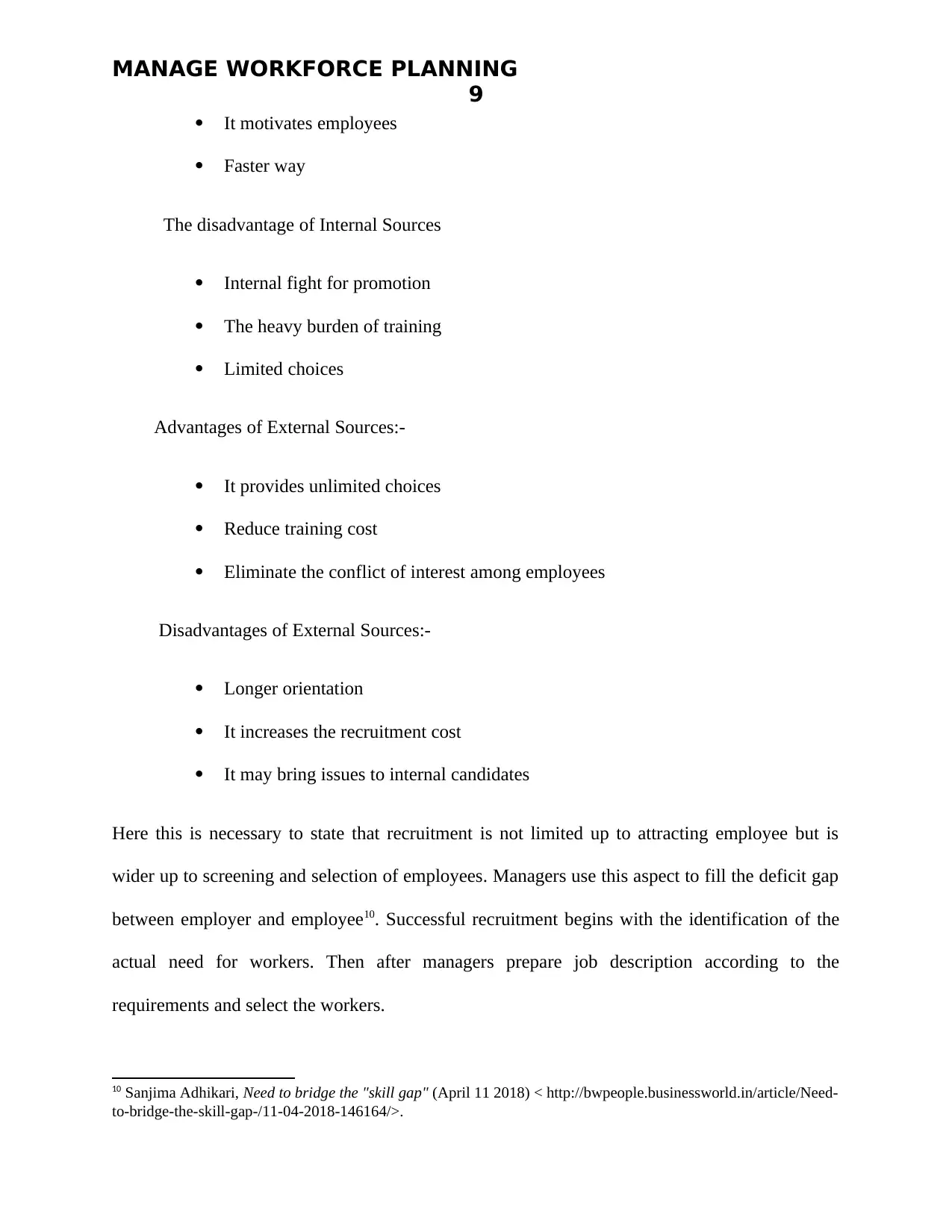
MANAGE WORKFORCE PLANNING
9
It motivates employees
Faster way
The disadvantage of Internal Sources
Internal fight for promotion
The heavy burden of training
Limited choices
Advantages of External Sources:-
It provides unlimited choices
Reduce training cost
Eliminate the conflict of interest among employees
Disadvantages of External Sources:-
Longer orientation
It increases the recruitment cost
It may bring issues to internal candidates
Here this is necessary to state that recruitment is not limited up to attracting employee but is
wider up to screening and selection of employees. Managers use this aspect to fill the deficit gap
between employer and employee10. Successful recruitment begins with the identification of the
actual need for workers. Then after managers prepare job description according to the
requirements and select the workers.
10 Sanjima Adhikari, Need to bridge the "skill gap" (April 11 2018) < http://bwpeople.businessworld.in/article/Need-
to-bridge-the-skill-gap-/11-04-2018-146164/>.
9
It motivates employees
Faster way
The disadvantage of Internal Sources
Internal fight for promotion
The heavy burden of training
Limited choices
Advantages of External Sources:-
It provides unlimited choices
Reduce training cost
Eliminate the conflict of interest among employees
Disadvantages of External Sources:-
Longer orientation
It increases the recruitment cost
It may bring issues to internal candidates
Here this is necessary to state that recruitment is not limited up to attracting employee but is
wider up to screening and selection of employees. Managers use this aspect to fill the deficit gap
between employer and employee10. Successful recruitment begins with the identification of the
actual need for workers. Then after managers prepare job description according to the
requirements and select the workers.
10 Sanjima Adhikari, Need to bridge the "skill gap" (April 11 2018) < http://bwpeople.businessworld.in/article/Need-
to-bridge-the-skill-gap-/11-04-2018-146164/>.
Paraphrase This Document
Need a fresh take? Get an instant paraphrase of this document with our AI Paraphraser
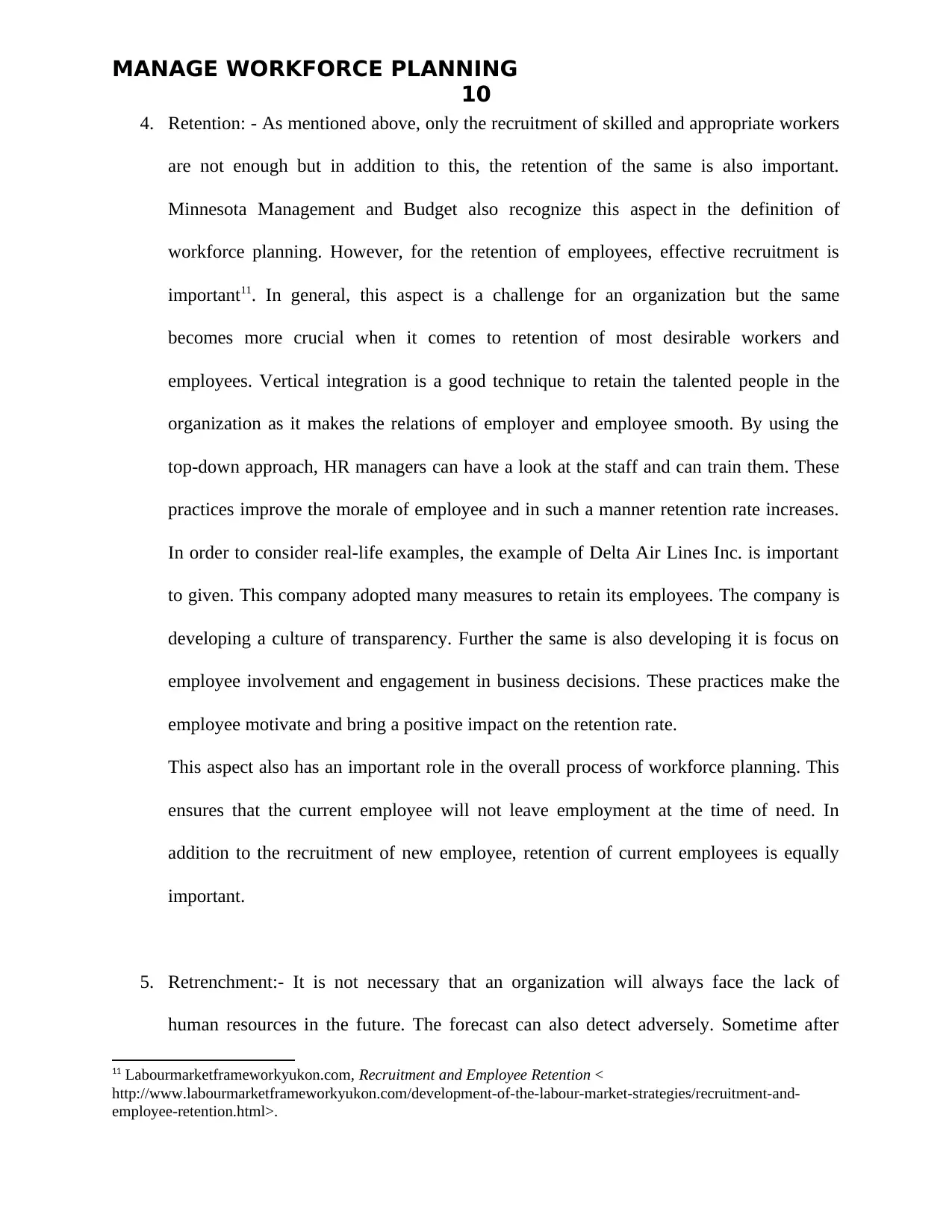
MANAGE WORKFORCE PLANNING
10
4. Retention: - As mentioned above, only the recruitment of skilled and appropriate workers
are not enough but in addition to this, the retention of the same is also important.
Minnesota Management and Budget also recognize this aspect in the definition of
workforce planning. However, for the retention of employees, effective recruitment is
important11. In general, this aspect is a challenge for an organization but the same
becomes more crucial when it comes to retention of most desirable workers and
employees. Vertical integration is a good technique to retain the talented people in the
organization as it makes the relations of employer and employee smooth. By using the
top-down approach, HR managers can have a look at the staff and can train them. These
practices improve the morale of employee and in such a manner retention rate increases.
In order to consider real-life examples, the example of Delta Air Lines Inc. is important
to given. This company adopted many measures to retain its employees. The company is
developing a culture of transparency. Further the same is also developing it is focus on
employee involvement and engagement in business decisions. These practices make the
employee motivate and bring a positive impact on the retention rate.
This aspect also has an important role in the overall process of workforce planning. This
ensures that the current employee will not leave employment at the time of need. In
addition to the recruitment of new employee, retention of current employees is equally
important.
5. Retrenchment:- It is not necessary that an organization will always face the lack of
human resources in the future. The forecast can also detect adversely. Sometime after
11 Labourmarketframeworkyukon.com, Recruitment and Employee Retention <
http://www.labourmarketframeworkyukon.com/development-of-the-labour-market-strategies/recruitment-and-
employee-retention.html>.
10
4. Retention: - As mentioned above, only the recruitment of skilled and appropriate workers
are not enough but in addition to this, the retention of the same is also important.
Minnesota Management and Budget also recognize this aspect in the definition of
workforce planning. However, for the retention of employees, effective recruitment is
important11. In general, this aspect is a challenge for an organization but the same
becomes more crucial when it comes to retention of most desirable workers and
employees. Vertical integration is a good technique to retain the talented people in the
organization as it makes the relations of employer and employee smooth. By using the
top-down approach, HR managers can have a look at the staff and can train them. These
practices improve the morale of employee and in such a manner retention rate increases.
In order to consider real-life examples, the example of Delta Air Lines Inc. is important
to given. This company adopted many measures to retain its employees. The company is
developing a culture of transparency. Further the same is also developing it is focus on
employee involvement and engagement in business decisions. These practices make the
employee motivate and bring a positive impact on the retention rate.
This aspect also has an important role in the overall process of workforce planning. This
ensures that the current employee will not leave employment at the time of need. In
addition to the recruitment of new employee, retention of current employees is equally
important.
5. Retrenchment:- It is not necessary that an organization will always face the lack of
human resources in the future. The forecast can also detect adversely. Sometime after
11 Labourmarketframeworkyukon.com, Recruitment and Employee Retention <
http://www.labourmarketframeworkyukon.com/development-of-the-labour-market-strategies/recruitment-and-
employee-retention.html>.
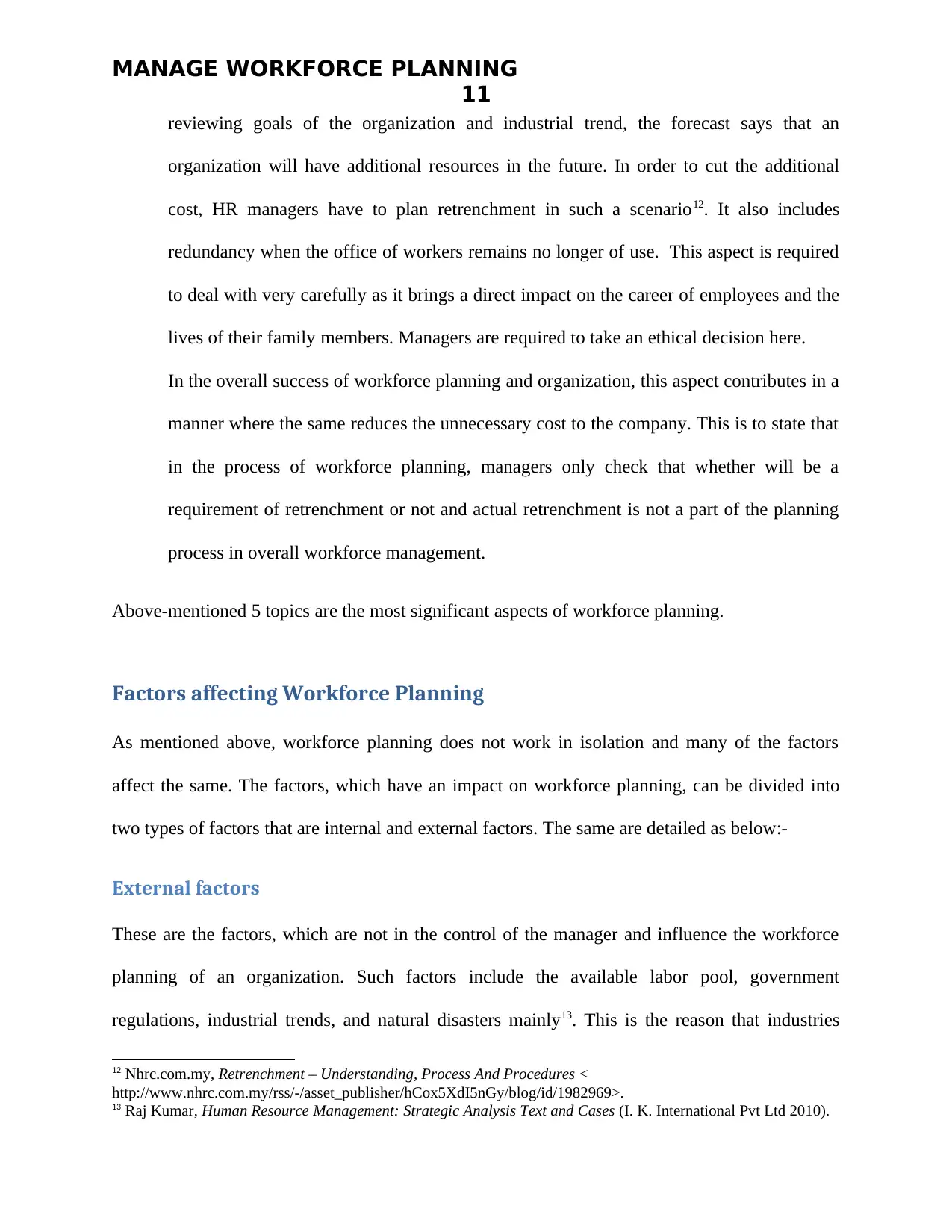
MANAGE WORKFORCE PLANNING
11
reviewing goals of the organization and industrial trend, the forecast says that an
organization will have additional resources in the future. In order to cut the additional
cost, HR managers have to plan retrenchment in such a scenario12. It also includes
redundancy when the office of workers remains no longer of use. This aspect is required
to deal with very carefully as it brings a direct impact on the career of employees and the
lives of their family members. Managers are required to take an ethical decision here.
In the overall success of workforce planning and organization, this aspect contributes in a
manner where the same reduces the unnecessary cost to the company. This is to state that
in the process of workforce planning, managers only check that whether will be a
requirement of retrenchment or not and actual retrenchment is not a part of the planning
process in overall workforce management.
Above-mentioned 5 topics are the most significant aspects of workforce planning.
Factors affecting Workforce Planning
As mentioned above, workforce planning does not work in isolation and many of the factors
affect the same. The factors, which have an impact on workforce planning, can be divided into
two types of factors that are internal and external factors. The same are detailed as below:-
External factors
These are the factors, which are not in the control of the manager and influence the workforce
planning of an organization. Such factors include the available labor pool, government
regulations, industrial trends, and natural disasters mainly13. This is the reason that industries
12 Nhrc.com.my, Retrenchment – Understanding, Process And Procedures <
http://www.nhrc.com.my/rss/-/asset_publisher/hCox5XdI5nGy/blog/id/1982969>.
13 Raj Kumar, Human Resource Management: Strategic Analysis Text and Cases (I. K. International Pvt Ltd 2010).
11
reviewing goals of the organization and industrial trend, the forecast says that an
organization will have additional resources in the future. In order to cut the additional
cost, HR managers have to plan retrenchment in such a scenario12. It also includes
redundancy when the office of workers remains no longer of use. This aspect is required
to deal with very carefully as it brings a direct impact on the career of employees and the
lives of their family members. Managers are required to take an ethical decision here.
In the overall success of workforce planning and organization, this aspect contributes in a
manner where the same reduces the unnecessary cost to the company. This is to state that
in the process of workforce planning, managers only check that whether will be a
requirement of retrenchment or not and actual retrenchment is not a part of the planning
process in overall workforce management.
Above-mentioned 5 topics are the most significant aspects of workforce planning.
Factors affecting Workforce Planning
As mentioned above, workforce planning does not work in isolation and many of the factors
affect the same. The factors, which have an impact on workforce planning, can be divided into
two types of factors that are internal and external factors. The same are detailed as below:-
External factors
These are the factors, which are not in the control of the manager and influence the workforce
planning of an organization. Such factors include the available labor pool, government
regulations, industrial trends, and natural disasters mainly13. This is the reason that industries
12 Nhrc.com.my, Retrenchment – Understanding, Process And Procedures <
http://www.nhrc.com.my/rss/-/asset_publisher/hCox5XdI5nGy/blog/id/1982969>.
13 Raj Kumar, Human Resource Management: Strategic Analysis Text and Cases (I. K. International Pvt Ltd 2010).
⊘ This is a preview!⊘
Do you want full access?
Subscribe today to unlock all pages.

Trusted by 1+ million students worldwide
1 out of 19
Related Documents
Your All-in-One AI-Powered Toolkit for Academic Success.
+13062052269
info@desklib.com
Available 24*7 on WhatsApp / Email
![[object Object]](/_next/static/media/star-bottom.7253800d.svg)
Unlock your academic potential
Copyright © 2020–2025 A2Z Services. All Rights Reserved. Developed and managed by ZUCOL.


